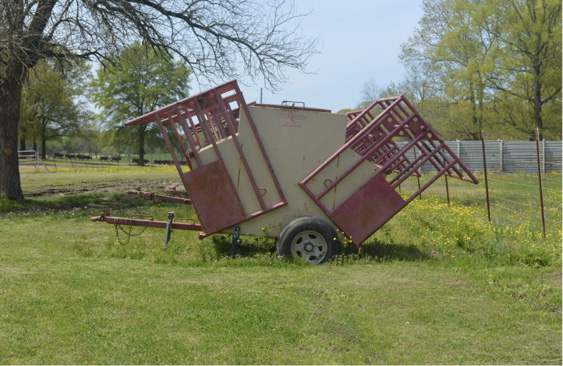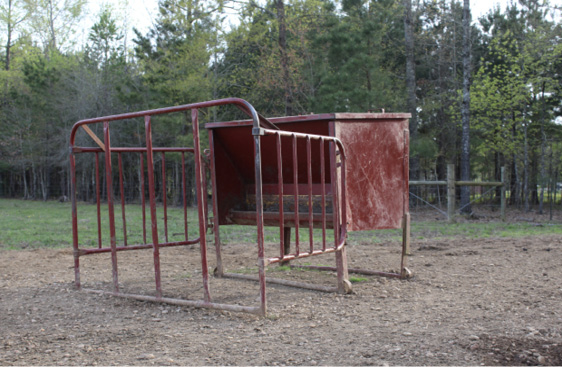Creep Feeding Beef Calves
Creep Feeding Beef Calves
Creep Feeding Basics
Preweaning supplementing, or “creep feeding,” is the nutrient supplementation of nursing beef calves. Supplements can include creep feeding with concentrated feeds or creep grazing with high-quality forage. Milk production in beef females typically peaks about 2 months after calving. Milk from a lactating beef cow offers only about half the nutrients that a 3- to 4-month-old calf needs for maximum growth. Calves need extra nutrients to perform to their genetic potential.
Pastures with low nutrient quality (most common in late summer) or low nutrient quantity (common in winter or during drought) cannot meet calves’ nutritional needs for maximum growth. Many warm-season perennial grasses in Mississippi pastures are often plentiful, but they do not maximize calf gains even when considered high-quality for the forage species. For example, both average daily gains and weaning weights increase for calves that have access to legume creep grazing on high quality bermudagrass pastures. These production impacts indicate a need to supplement calves’ diets with high-quality feed before weaning. High quality grazing is usually the most inexpensive source of additional nutrients for nursing calves. Calves raised on high-quality, abundant forage usually do not benefit much from additional creep feeding.
Typically, creep access to supplemental feed or forage requires creep feeders or gates; these restrict access to the supplement by larger or more mature cattle while allowing calves to feed on or graze supplementation at will. Creep feeding “gates” can be created with a single strand of electrified polywire strategically attached to T-posts and placed around creep supplement. Wires should be 36 to 42 inches above the ground, so calves can pass underneath but mature cattle cannot. Creep gates are also commercially available and can be placed on self-feeders or stand-alone creep feeders (Figure 1). Creep entrance slots should be 18 inches wide.


Figure 1. Example creep feeders for beef cows.
Creep Feedstuffs
A variety of different feedstuffs and feedstuff combinations are suitable for creep supplementation of beef calves. When selecting feedstuffs for creep diets, consider forage conditions and milking levels of herd females to determine which feedstuffs will be most beneficial to calves. Take feedstuff nutrient content, price, and handling characteristics into account as well. In creep feeding situations, calves often have free access to supplement. Soybean hull pellets, corn gluten feed, corn, soybean meal, cottonseed meal, and commercially mixed creep supplements containing multiple ingredients are commonly used creep supplements in Mississippi. Do not use cottonseed meal for creep feeding calves less than 4 months old because of gossypol concerns.
Creep feedstuffs must be palatable to calves. Whole or rolled grains are generally more palatable than finely ground grains. Larger feed particles also reduce dust and may decrease waste. Adding cane molasses to creep rations decreases dust problems, increases feed palatability, and reduces feedstuff separation. Use 3 to 5 pounds of molasses per 100 pounds of creep feed or 60 to 100 pounds of molasses per ton of creep feed.
It may be difficult to start calves on creep feed when they have access to adequate milk and high quality forage. To encourage creep feed intake, offer creep supplement in areas the herd often visits. Feeding the herd small amounts of feed starting a few days before beginning creep feeding is a good training method, because calves quickly learn to eat with their dams. Scatter feed or hay in and around the creeping area so cows will stay nearby. In large pastures, consider using several creep feeders.
When providing free-choice creep supplement to calves, maintain a constant supply of feed in creep feeders. Allowing creep feeders to empty completely can encourage calves to overeat when feeders are refilled. Make sure that feed containing multiple ingredients is thoroughly mixed to reduce feed sorting by calves.
It is important to provide feedstuffs that will not cause digestive disturbances when fed free choice. Calves consuming large quantities of starch in grain-based creep feeds may experience acidosis. Limiting supplement intake can prevent acidosis. It is possible to limit intake by offering creep feeders on a daily basis, but this is a very labor-intensive option. Adding salt to the creep feed can also limit intake. Young calves are very sensitive to changes in salt levels, so increase salt levels gradually. A creep feed supplement should contain about 8–10 percent salt, but it may be necessary to begin with only 2–3 percent salt to encourage calves to eat the supplement. Frequently monitor creep feed intake, and adjust salt levels as needed. If intake begins to exceed 1.5 percent of body weight, control intake by adding more salt or by hand feeding defined quantities of supplement. Meal forms of creep supplement are more suitable to mix with salt than pelleted forms. In addition, remember that salt can corrode metal creep feeders but works well in wood, plastic, or rubber feeders.
Limiting intake of high-protein creep supplements reduces added calf weight gains by about one-third to one-half compared to unlimited creep feeding. A limit-fed creep feeding system can increase the feed conversion efficiency and prevent calves from becoming overly fleshy. One possible strategy is to limit feed either about 1 pound per day of a protein creep feed or about 3 pounds per day of an energy creep feed. Intake of high-protein creep feed should be limited to about 1 pound per day. This limit produces favorable effects on forage digestibility and minimizes the use of protein for energy, maximizing creep feed efficiency.
Creep Grazing
Forages are important for proper calf digestive tract development. Functional rumen development starts as soon as calves consume roughage from forages or from high-roughage feedstuffs such as cottonseed hulls. Nursing calves begin ruminating around three months of age when they consume roughage. The rumen develops considerably slower when calves consume only milk and concentrate feeds.
Creep grazing can save money because high-quality creep forage can be grown more inexpensively than creep feed can be purchased. To implement creep grazing, plant small acreages of high-quality forage adjacent to pastures grazed by cow-calf pairs. Forages well suited for use in a creep grazing system are high in forage quality and readily available. If creep forage growth becomes excessive, allow mature cattle to graze it until the forage reaches a level manageable by the calves alone.
In Mississippi, annual ryegrass is a forage commonly used for creep grazing. Other lush, cool-season forages, such as cereal rye, wheat, oats, and nontoxic endophyte-infected tall fescue, may work well in creep grazing management systems. Legumes, such as clovers and alfalfa, are also good candidates for inclusion in a creep grazing paddock. Annual grasses, such as sorghum-sudan and pearl millet, are good warm-season options and can initially be stocked at 6–10 calves per acre. The high-quality, warm-season forage forb chicory is another creep grazing option, as is aeschynomene, a high-quality tropical legume. When considering creep grazing for the calf crop, do not overlook the planning and labor required for creep forage establishment. Calf gains from creep grazing are often similar to or slightly less than gains from grain-based creep programs.
Calf Performance
Creep Feed Intake and Efficiency
Feed intake and efficiency are important cost factors in beef cattle operations. The less feed required per pound of calf gain, the greater the feed efficiency. Typically, creep supplementation is not very feed efficient, but efficiency varies according to creep feed and total diet composition. Supplemental feed efficiency can range from 4–18 pounds of feed consumed per 1 pound of calf weight gain. With concentrate-based creep feeds, the conversion is usually greater than 8 pounds (and often averages 9–10 pounds) of feed per additional pound of gain beyond noncreep-fed calves. Ionophores, such as monensin and lasalocid, can improve creep-feeding efficiency. Growth-promoting implants are also available for nursing calves and can change the economics of creep supplementation.
Breed differences exist in creep feed intake, but most calves prefer milk over palatable creep feed and forage; calves often nurse to capacity before consuming creep feed or forage. However, calves will substitute creep feed for forage when given the opportunity. Consuming grain-based creep feed does not affect milk intake, but it does decrease forage intake. In many cases, as cow milk yield increases, calf creep feed intake decreases. Nursing calves with access to creep supplement may maintain their milk intake but increase their overall intake (milk + forage + creep supplement). The amount of forage area provided for creep grazing impacts calf gain per acre.
While high-energy creep feeds can decrease forage digestibility and intake, high-protein creep feeds can increase forage digestibility and intake. Soybean hulls are an exception to this rule. They contain high levels of both energy and digestible fiber. Fiber-based creep feeds containing mostly soybean hulls will not harm forage intake or digestion in nursing calves. Limiting the intake of high-energy creep feed can also partially offset decreases in fiber digestion.
Feed efficiency may improve when using high-protein supplements (less than 20 percent protein) compared to high-energy low-protein grains and by-product feeds. This occurs with both limited and unlimited creep feeding. Typically, calf average daily gains increase as the protein level in the diet increases.
Weaning Weight
The weaning weight advantages of creep feeding are well documented. Weaning weight differences between creep-fed and noncreep-fed calves can approach 100 pounds under ideal circumstances. Creep feeding also increases heifer growth response to growth stimulant implants.
The length of the creep feeding period affects calf performance. Preweaning calf average daily gains may increase as the length of the creep feeding period increases. For example, creep feeding for only one month may provide no advantage in preweaning or postweaning growth performance, but creep feeding for two or three months may result in improved preweaning gains. Generally, significant improvements in calf performance require at least 60 days of creep supplementation. A 2-month creep feeding period usually produces the most efficient creep-feeding gains compared with 1- or 3-month periods.
Dam Performance
Creep feeding does not reduce nursing pressure on cows and heifers. In general, changing the length of the creep feeding period does not impact cow performance. Yet cows with creep-grazed calves may have more body condition at weaning and entering late gestation than cows with noncreep-grazed calves. There is some evidence that access to creep feeding can result in heavier calves at birth in the subsequent calf. Nonetheless, management strategies to minimize calving difficulty in the herd should stress proper bull selection, heifer development, and adequate dam nutrition.
Producers interested in monitoring the maternal performance of herd females may choose not to creep feed calves to avoid masking low milk production. When calves have access to creep supplementation, differences in dam milk production may not impact calf preweaning growth performance. Calves nursing cows or heifers with lower milk production than others in the herd may compensate for this by increasing creep supplement intake. Differences in calf growth due to dam’s milk production may be difficult to assess when creep supplementation is used. However, creep supplementation is likely to result in heavier calves at weaning with greater potential returns to producers who market their calves at weaning. If creep feeding is implemented, weigh calves prior to starting supplementation to get an idea of the dam’s milking performance and the calf’s growth performance up to that point.
Long Term Implications
Heifers
Many producers express concern over the effects of creep feeding and preweaning growth on the future reproductive performance and maternal ability of replacement heifers. Research has shown that while creep-fed heifers were heavier at weaning than noncreep-fed heifers, the weight advantage was not sustained through yearling age. Additionally, creep feeding negatively impacted the subsequent productivity of heifers. Creep-fed dams had decreased longevity, fewer calves weaned, and lower average calf weaning weight. Other studies have shown that creep feeding results in heavier, fatter heifers at breeding but does not affect pregnancy, weaning, or calving rates in first-calf heifers.
In replacement beef heifers given access to creep feed as calves, milk production may be reduced at first lactation. Increasing dietary protein level in creep feed can improve lactation performance during the first 2 months after first calving. However, total milk production over the entire lactation may not improve with the increased crude protein in creep feed. Long-term creep feeding can increase the amount of subcutaneous fat and the size of fat cells in the udder.
If preweaning nutritional programs do not produce normal weaning weights without creep supplementation, then creep feeding to achieve acceptable weights may not harm long-term maternal performance of heifers. Creep feeding may even decrease heifer age at puberty. Avoid creep-feeding programs that produce overly fat heifers at weaning. For young heifers, creep grazing may be more suitable than creep feeding of high-energy supplements.
Separate male from female calves to increase preweaning growth and weaning weights of male calves and avoid potential reductions in future milking performance of female calves retained as replacements. If females can be identified that will not be raised for breeding stock and will instead enter cattle finishing operations, they can be sorted out with male calves for purposes of creep supplementation. This practice requires early selection of replacement heifers, which may not be ideal in many operations. It also reduces contemporary group size for making performance comparisons. The major drawbacks to creating multiple nutritional groups within the calf crop are limited pasture or facilities and sorting limitations due to breeding group requirements during the breeding season.
Bulls
When postweaning development programs support only low to moderate rates of gain (1.5 pounds per head daily), creep-fed calves may gain slower than noncreep-fed calves. However, calves on higher planes of postweaning nutrition or calves with higher potential for postweaning growth may be unaffected by preweaning supplementation. For example, creep feeding is more likely to affect heifers than bulls. Similarly, calves with higher yearling weight expected progeny differences are less likely to be affected by preweaning supplementation than are calves with less genetic growth potential. Creep feeding usually does not affect the average daily gains of performance-tested bulls that are developed for average daily gains in excess of 3 pounds. However, creep-fed bulls are generally heavier than noncreep-fed bulls at the start of postweaning tests. They also maintain a weight-per-day-of-age advantage throughout postweaning performance test periods on both feedlot and pasture-based performance tests. Creep supplementation can help achieve higher bull yearling weights for improved seedstock marketability. Creep feeding usually does not affect postweaning average daily gain, yearling pelvic area, or yearling scrotal circumference.
Finishing Performance
Creep feeding nursing calves generally increases their preweaning growth performance. Cattle entering feedlots at higher weights because of creep supplementation may need fewer days on feed until harvest. Calves familiar with feeds and feeding equipment through a creep-feeding program often consume more feed during the first few weeks after arrival in a finishing operation. Creep supplementation has relatively little influence on growth efficiency during the finishing phase if calves are managed to harvest at a similar fat thickness endpoint. While feed efficiency is not impacted, feed intake and growth performance may be higher during the finishing period in calves previously creep fed. These finishing growth rate improvements may increase as the protein level of the creep supplement increases. Creep feeding can increase Quality Grades at harvest and enable more cattle to achieve Choice Quality Grade at 14 months of age.
Other Considerations
Profitability of creep feeding depends largely on current market conditions. Typically, creep feeding is more profitable when calf prices are high than when calf prices are low. Increased average daily gains and weaning weights due to creep supplementation often improve marketability of seedstock cattle such as bulls. Creep supplementation may be more attractive when forage quantity or quality is low and cannot meet calf nutritional needs to support acceptable growth rates. Time of year and forage conditions can also impact the effectiveness of creep supplementation.
Creep feeding affects preweaning and postweaning calf performance. Some producers creep feed calves for a short period before weaning to familiarize them with supplemental feed and ease their transition to the postweaning diet. This practice trains calves to eat from feed bunks and adds to calf marketability by producing “bunk broke” calves. Calves accustomed to consuming feed are more likely to eat any palatable feed offered at auction markets. This could reduce shrinkage from ranch to sale ring.
When making decisions about supplementing nursing calves, take into account cost and availability of feed and forage supplements, replacement heifer concerns, calf prices, and calf marketing plans. The cost of creep supplementation depends on the cost of creep feed and calf feed conversion (Table 1). For creep feeding to be profitable, the value of improvements in calf gains and marketability must offset the cost of supplementation. The per pound value of additional calf weight gains often declines as commercial calf weights increase (price slide). In addition, with higher calf prices, greater discounts are often assessed as calves increase in weight. Depending on the program, creep supplementation may produce overly fleshy calves. Some markets discriminate against calves with excess condition, lowering the value-added gains from creep supplementation that results in fleshy calves.
Table 1. Cost of creep supplementation per pound of gain.
|
Feed conversion, pounds of extra feed per pound of extra gain |
Cost of creep feed, dollars per ton |
||||||
|
$125 |
$150 |
$175 |
$200 |
$225 |
$250 |
$275 |
|
|
Cost of creep supplementation, dollars per pound of gain |
|||||||
|
4 |
0.25 |
0.30 |
0.35 |
0.40 |
0.45 |
0.50 |
0.55 |
|---|---|---|---|---|---|---|---|
|
5 |
0.31 |
0.38 |
0.44 |
0.50 |
0.56 |
0.63 |
0.69 |
|
6 |
0.38 |
0.45 |
0.53 |
0.60 |
0.68 |
0.75 |
0.83 |
|
7 |
0.44 |
0.53 |
0.61 |
0.70 |
0.79 |
0.88 |
0.96 |
|
8 |
0.50 |
0.60 |
0.70 |
0.80 |
0.90 |
1.00 |
1.10 |
|
9 |
0.56 |
0.68 |
0.79 |
0.90 |
1.01 |
1.13 |
1.24 |
|
10 |
0.63 |
0.75 |
0.88 |
1.00 |
1.13 |
1.25 |
1.38 |
|
11 |
0.69 |
0.83 |
0.96 |
1.10 |
1.24 |
1.38 |
1.51 |
|
12 |
0.75 |
0.90 |
1.05 |
1.20 |
1.35 |
1.50 |
1.65 |
|
13 |
0.81 |
0.98 |
1.14 |
1.30 |
1.46 |
1.63 |
1.79 |
A 2007–2008 survey conducted by USDA’s National Health Monitoring System reported that 29.2 percent of cow-calf operations in the Southeast U.S. use creep feeding. When making a decision about preweaning supplementation, consider several factors, including forage conditions, milk production levels, calf growth potentials, post-weaning marketing plans, feed costs, forage costs, pasture carrying capacity, calf prices, and price differentials for calves of varying body condition. There are both advantages and disadvantages to creep feeding beef calves. Creep supplementation is a management decision that should be reevaluated with each calf crop. For more information on creep feeding, contact your local MSU Extension office.
References
Baker, J. F., R. C. Vann, & W. E. Neville, Jr. 2002. Evaluations of genotypexenvironment interactions of beef bulls performance-tested in feedlot or pasture. Journal of Animal Science, 80: 1716–1724.
Corriher, V. A., G. M. Hill, J. G. Andrae, M. A. Froetschel, & B. G. Mullinix, Jr. 2007. Cow and calf performance on Coastal or Tifton 85 Bermudagrass pastures with aeschynomene creep-grazing paddocks. Journal of Animal Science, 85: 2762–2771.
Faulkner, D. B., D. F. Hummel, D. D. Buskirk, L. L. Berger, D. F. Parrett, & G. F. Cmarik. 1994. Performance and nutrient metabolism by nursing calves supplemented with limited or unlimited corn or soyhulls. Journal of Animal Science, 72: 470–477.
Faulkner, D. B., & F. A. Ireland. 1999. Performance of nursing calves fed supplement with varying levels of protein. University of Illinois.
Martin, T. G., R. P. Lemenager, G. Srinivasan, & R. Alenda. 1981. Creep feed as a factor influencing performance of cows and calves. Journal of Animal Science, 53: 33–39.
Soto-Navarro, S. A., M. H. Knight, G. P. Lardy, M. L. Bauer, & J. S. Caton. 2004. Effect of fiber-based creep feed on intake, digestion, ruminal fermentation, and microbial efficiency in nursing calves. Journal of Animal Science, 82: 3560–3566.
Tarr, S. L., D. B. Faulkner, D. D. Buskirk, F. A. Ireland, D. F. Parrett & L. L. Berger. 1994. The value of creep feeding during the last 84, 56, or 28 days prior to weaning on growth performance of nursing calves grazing endophyte-infected tall fescue. Journal of Animal Science: 1084–1094.
U. S. Department of Agriculture. 2009. National Animal Health Monitoring System BEEF 2007-8.
The information given here is for educational purposes only. References to commercial products, trade names, or suppliers are made with the understanding that no endorsement is implied and that no discrimination against other products or suppliers is intended.
Publication 2524 (POD-04-22)
Revised by Brandi Karisch, PhD, Associate Extension/Research Professor, Animal and Dairy Sciences. Originally written by Jane A. Parish, PhD, Professor and Head, North Mississippi Research and Extension Center, and Justin Rhinehart, PhD, former Assistant Extension Professor, Animal and Dairy Sciences.
The Mississippi State University Extension Service is working to ensure all web content is accessible to all users. If you need assistance accessing any of our content, please email the webteam or call 662-325-2262.





